1.4: Motion of the Moon
- Page ID
- 30852
\( \newcommand{\vecs}[1]{\overset { \scriptstyle \rightharpoonup} {\mathbf{#1}} } \)
\( \newcommand{\vecd}[1]{\overset{-\!-\!\rightharpoonup}{\vphantom{a}\smash {#1}}} \)
\( \newcommand{\id}{\mathrm{id}}\) \( \newcommand{\Span}{\mathrm{span}}\)
( \newcommand{\kernel}{\mathrm{null}\,}\) \( \newcommand{\range}{\mathrm{range}\,}\)
\( \newcommand{\RealPart}{\mathrm{Re}}\) \( \newcommand{\ImaginaryPart}{\mathrm{Im}}\)
\( \newcommand{\Argument}{\mathrm{Arg}}\) \( \newcommand{\norm}[1]{\| #1 \|}\)
\( \newcommand{\inner}[2]{\langle #1, #2 \rangle}\)
\( \newcommand{\Span}{\mathrm{span}}\)
\( \newcommand{\id}{\mathrm{id}}\)
\( \newcommand{\Span}{\mathrm{span}}\)
\( \newcommand{\kernel}{\mathrm{null}\,}\)
\( \newcommand{\range}{\mathrm{range}\,}\)
\( \newcommand{\RealPart}{\mathrm{Re}}\)
\( \newcommand{\ImaginaryPart}{\mathrm{Im}}\)
\( \newcommand{\Argument}{\mathrm{Arg}}\)
\( \newcommand{\norm}[1]{\| #1 \|}\)
\( \newcommand{\inner}[2]{\langle #1, #2 \rangle}\)
\( \newcommand{\Span}{\mathrm{span}}\) \( \newcommand{\AA}{\unicode[.8,0]{x212B}}\)
\( \newcommand{\vectorA}[1]{\vec{#1}} % arrow\)
\( \newcommand{\vectorAt}[1]{\vec{\text{#1}}} % arrow\)
\( \newcommand{\vectorB}[1]{\overset { \scriptstyle \rightharpoonup} {\mathbf{#1}} } \)
\( \newcommand{\vectorC}[1]{\textbf{#1}} \)
\( \newcommand{\vectorD}[1]{\overrightarrow{#1}} \)
\( \newcommand{\vectorDt}[1]{\overrightarrow{\text{#1}}} \)
\( \newcommand{\vectE}[1]{\overset{-\!-\!\rightharpoonup}{\vphantom{a}\smash{\mathbf {#1}}}} \)
\( \newcommand{\vecs}[1]{\overset { \scriptstyle \rightharpoonup} {\mathbf{#1}} } \)
\( \newcommand{\vecd}[1]{\overset{-\!-\!\rightharpoonup}{\vphantom{a}\smash {#1}}} \)
\(\newcommand{\avec}{\mathbf a}\) \(\newcommand{\bvec}{\mathbf b}\) \(\newcommand{\cvec}{\mathbf c}\) \(\newcommand{\dvec}{\mathbf d}\) \(\newcommand{\dtil}{\widetilde{\mathbf d}}\) \(\newcommand{\evec}{\mathbf e}\) \(\newcommand{\fvec}{\mathbf f}\) \(\newcommand{\nvec}{\mathbf n}\) \(\newcommand{\pvec}{\mathbf p}\) \(\newcommand{\qvec}{\mathbf q}\) \(\newcommand{\svec}{\mathbf s}\) \(\newcommand{\tvec}{\mathbf t}\) \(\newcommand{\uvec}{\mathbf u}\) \(\newcommand{\vvec}{\mathbf v}\) \(\newcommand{\wvec}{\mathbf w}\) \(\newcommand{\xvec}{\mathbf x}\) \(\newcommand{\yvec}{\mathbf y}\) \(\newcommand{\zvec}{\mathbf z}\) \(\newcommand{\rvec}{\mathbf r}\) \(\newcommand{\mvec}{\mathbf m}\) \(\newcommand{\zerovec}{\mathbf 0}\) \(\newcommand{\onevec}{\mathbf 1}\) \(\newcommand{\real}{\mathbb R}\) \(\newcommand{\twovec}[2]{\left[\begin{array}{r}#1 \\ #2 \end{array}\right]}\) \(\newcommand{\ctwovec}[2]{\left[\begin{array}{c}#1 \\ #2 \end{array}\right]}\) \(\newcommand{\threevec}[3]{\left[\begin{array}{r}#1 \\ #2 \\ #3 \end{array}\right]}\) \(\newcommand{\cthreevec}[3]{\left[\begin{array}{c}#1 \\ #2 \\ #3 \end{array}\right]}\) \(\newcommand{\fourvec}[4]{\left[\begin{array}{r}#1 \\ #2 \\ #3 \\ #4 \end{array}\right]}\) \(\newcommand{\cfourvec}[4]{\left[\begin{array}{c}#1 \\ #2 \\ #3 \\ #4 \end{array}\right]}\) \(\newcommand{\fivevec}[5]{\left[\begin{array}{r}#1 \\ #2 \\ #3 \\ #4 \\ #5 \\ \end{array}\right]}\) \(\newcommand{\cfivevec}[5]{\left[\begin{array}{c}#1 \\ #2 \\ #3 \\ #4 \\ #5 \\ \end{array}\right]}\) \(\newcommand{\mattwo}[4]{\left[\begin{array}{rr}#1 \amp #2 \\ #3 \amp #4 \\ \end{array}\right]}\) \(\newcommand{\laspan}[1]{\text{Span}\{#1\}}\) \(\newcommand{\bcal}{\cal B}\) \(\newcommand{\ccal}{\cal C}\) \(\newcommand{\scal}{\cal S}\) \(\newcommand{\wcal}{\cal W}\) \(\newcommand{\ecal}{\cal E}\) \(\newcommand{\coords}[2]{\left\{#1\right\}_{#2}}\) \(\newcommand{\gray}[1]{\color{gray}{#1}}\) \(\newcommand{\lgray}[1]{\color{lightgray}{#1}}\) \(\newcommand{\rank}{\operatorname{rank}}\) \(\newcommand{\row}{\text{Row}}\) \(\newcommand{\col}{\text{Col}}\) \(\renewcommand{\row}{\text{Row}}\) \(\newcommand{\nul}{\text{Nul}}\) \(\newcommand{\var}{\text{Var}}\) \(\newcommand{\corr}{\text{corr}}\) \(\newcommand{\len}[1]{\left|#1\right|}\) \(\newcommand{\bbar}{\overline{\bvec}}\) \(\newcommand{\bhat}{\widehat{\bvec}}\) \(\newcommand{\bperp}{\bvec^\perp}\) \(\newcommand{\xhat}{\widehat{\xvec}}\) \(\newcommand{\vhat}{\widehat{\vvec}}\) \(\newcommand{\uhat}{\widehat{\uvec}}\) \(\newcommand{\what}{\widehat{\wvec}}\) \(\newcommand{\Sighat}{\widehat{\Sigma}}\) \(\newcommand{\lt}{<}\) \(\newcommand{\gt}{>}\) \(\newcommand{\amp}{&}\) \(\definecolor{fillinmathshade}{gray}{0.9}\)While we can use the timing and position of the Sun to mark the days and the years, early people used the motion of the Moon to define the month. Also, as with the day and the year, we have two ways to define a month. A synodic month marks the amount of time it takes for the Moon to go through a complete set of phases, from full moon to full moon, about 29.5 days. On other hand, a sidereal month marks one complete orbit of the Moon 360 degrees around the Earth. Because the Earth moves along its orbit around the Sun, a sidereal month is about two days longer than a synodic month.
Days, months, and years make up the basic units of our calendar. However, neither the day nor the month make a convenient fraction of a year. At roughly thirty days long, a month does divide evenly into the 365.25 days of a year. Five extra days need to be added to the calendar to fill out a standard year and an extra day needs to be added every four years (called a leap year) to keep the calendar standard. The ancient Romans used to tack the extra days at arbitrary times throughout the year until Julius Caesar standardized the length of each month, scattering the extra days throughout the year. To this day, we still use the months defined in the Julian calendar, with some modifications.
People often refer to the “Dark Side of the Moon,” but in reality, all areas of the Moon receive illumination from the Sun throughout the month. The Moon is tidally locked to the Earth, which means the same side of Moon always faces the Earth. Instead, we will refer to the two hemispheres of the Moon as the near side and the far side. We have been familiar with the near side of the Moon since the first people looked up and saw it in the sky hundreds of thousands of years ago. However, we had no idea what the far side looked up until the 1960s, when we sent probes around to the far side that transmitted pictures of its surface back to Earth.
The phases of the Moon refer to how much of the near side is illuminated by the Sun and therefore visible from Earth. During full moon, the entire near side is reflecting light from the Sun toward Earth and we can see its entire surface. After full moon, the Moon is said to be waning, as less and less of the near side receives light from the Sun. The Moon moves from gibbous phase to quarter phase to crescent phase. At new moon, none of the near side is receiving light from the Sun and none of it is visible from the Earth. After new moon, we say the Moon is waxing through crescent phase, quarter, phase, and gibbous phase as more and more of the near side receives sunlight until the next full moon phase.

Sometimes, during full moon phase, the Moon passes through the Earth’s shadow, which blocks the Sun’s light. A lunar eclipse, where the Moon appears to disappear, can be either a partial eclipse, where only part of the Moon is in shadow or a total eclipse, when all of the Moon passes through the Earth’s shadow.
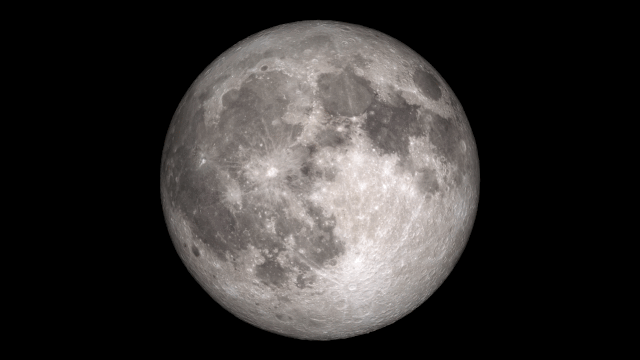 Lunar Eclipse.
Lunar Eclipse.
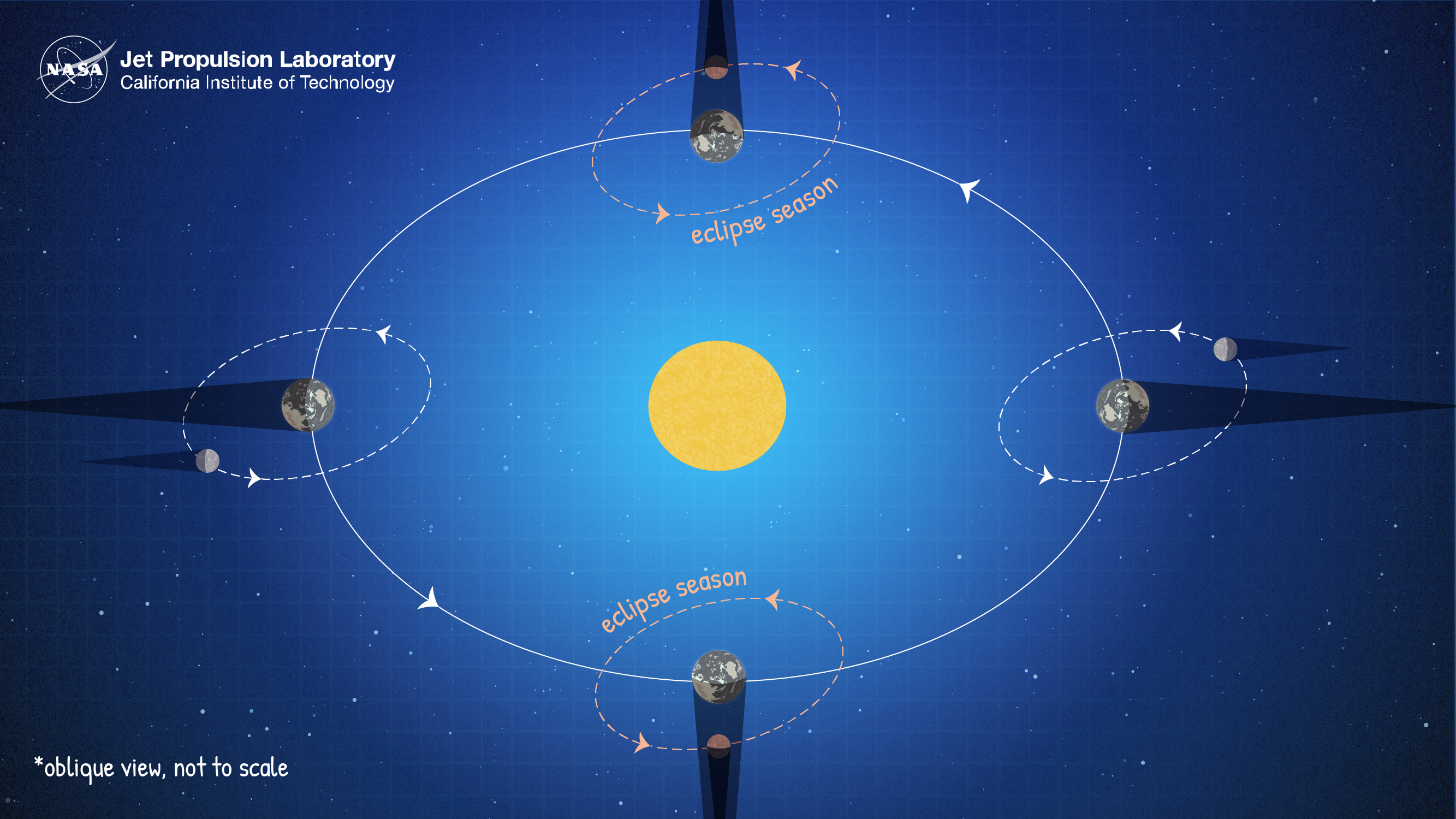 Lunar Eclipse.
Lunar Eclipse.
Credit: NASA/JPL-Caltech
Likewise, during new moon phase, the Moon sometimes casts its shadow across the Earth’s surface, causing a solar eclipse. During a solar eclipse, the Moon’s shadow has two parts, the outer, light part penumbra and the darker central umbra. Areas of the Earth covered by the Moon’s umbra experience a total eclipse, where all the Sun’s disk it blocked the Moon. During a total solar eclipse, we can see the Sun’s corona, or outer atmosphere. Normally, the light from the Sun’s surface is too bright for us to see the corona, but during a total eclipse, the Moon’s shadow blocks all of the light from the Sun’s surface, allowing is to see the corona. Areas of the Earth touched by the penumbra of the Moon’s shadow experience a partial eclipse. During a partial solar eclipse, only a portion of the Sun’s disk is blocked and the corona is not visible. When the Moon is at apogee, its furthest distance from the Earth, its apparent size can be too small to cover the entire disk of the Sun. When this occurs, we can have an annular eclipse, where a ring of the Sun can be seen around the Moon’s shadow.
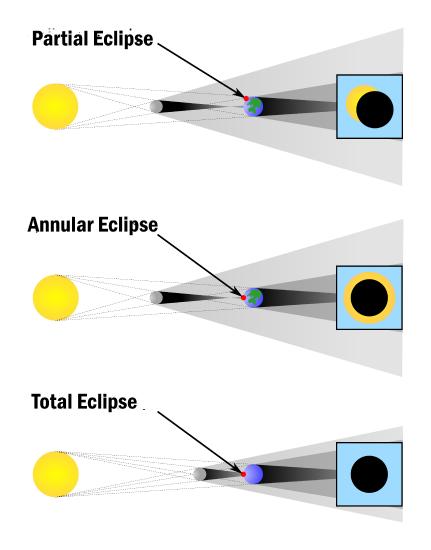 Partial, Annular, and Total Solar Eclipses
Partial, Annular, and Total Solar Eclipses
MesserWoland/CC BY-SA (https:/creativecommons.org/licenses/by-sa/3.0);
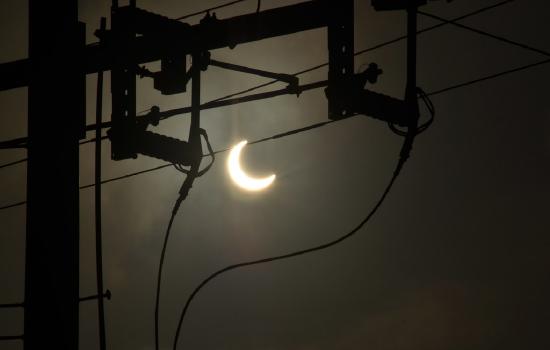 Partial Solar Eclipse.
Partial Solar Eclipse.
by Malingering is licensed under CC BY-NC-ND 2.0
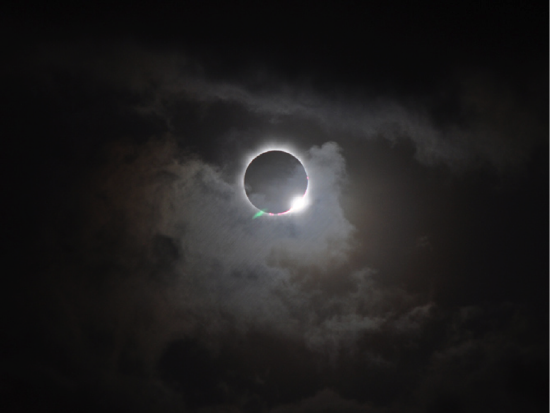 Total Solar Eclipse with the Corona Visible.
Total Solar Eclipse with the Corona Visible.
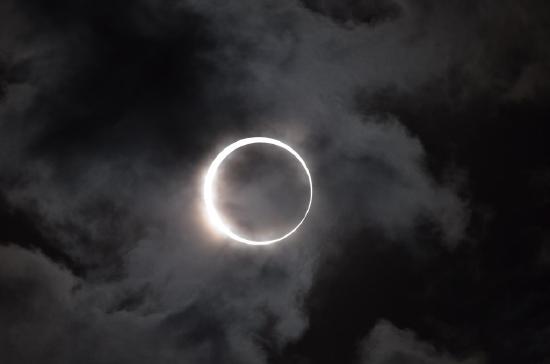 Annular Solar Eclipse
Annular Solar Eclipse
Photo by Drew Rae from Pexels;
Why do we not see an eclipse every new moon and every full moon? The Moon’s orbit is tilted with respect to the ecliptic. Therefore, eclipses only occur when the positions of the Sun, the Earth, and Moon form a straight line.

